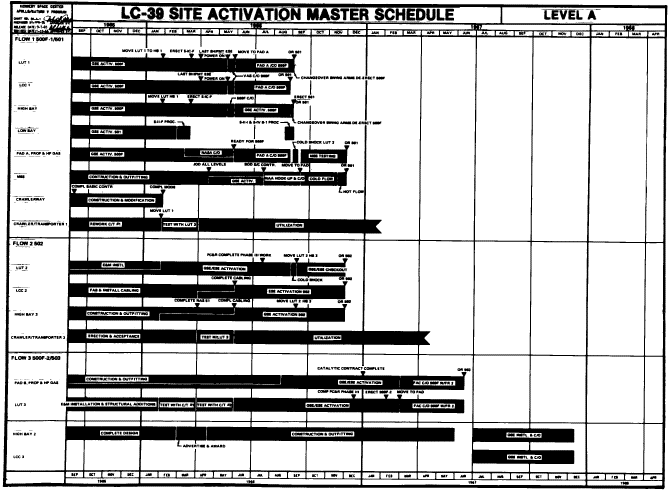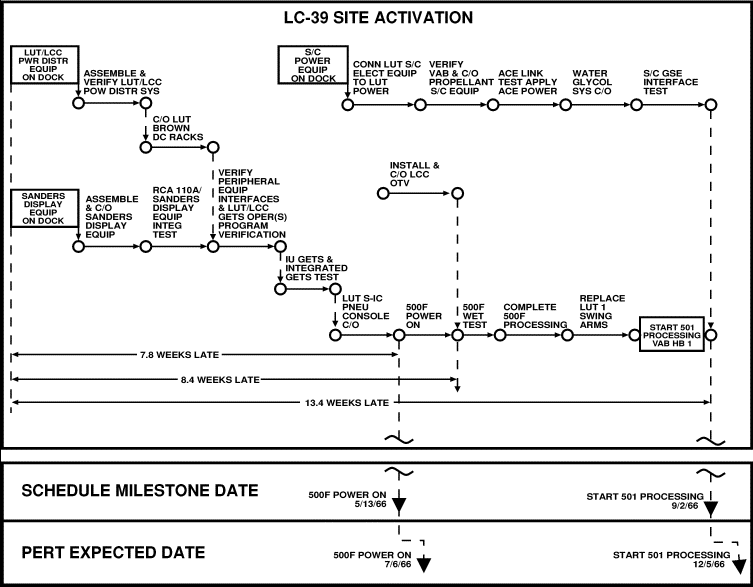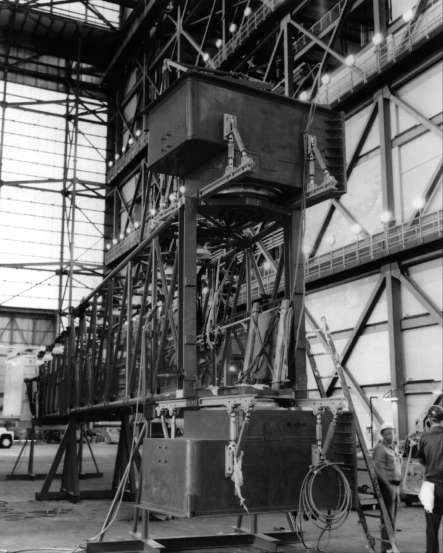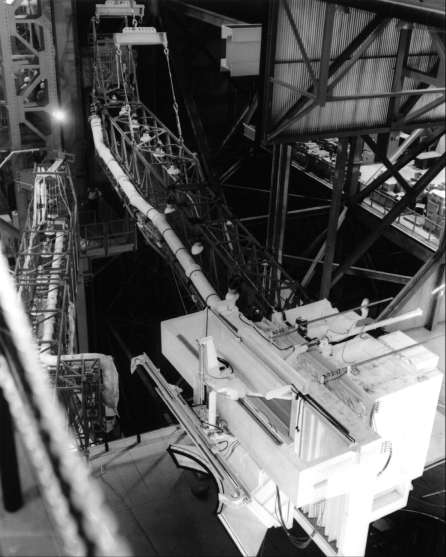
"Negative Slack" in "Critical paths"

LC-39 site activation master schedule, level A, 10 January 1966. The level B chart for approximately the same date is shown in chapter 15-1.
The nerve center for site activation lay in John Potate's scheduling office. Potate, a young engineer from Georgia Tech, had previously worked on site activation for LC-34 and LC-37 and brought that experience to his new and much bigger assignment. Supported by a Boeing team, Potate put the B PERT network to use. The scheduling office had little control over the A networks; the Apollo Program Offices at NASA Headquarters and KSC set the key milestone dates. The line organization level-C networks provided valuable data, but were too detailed for quick program evaluation. KSC officials, in large part, based their program decisions on the B networks - the level where Potate reconciled C-level capabilities with A-level deadlines. Potate relied heavily on PERT to identify problems. A computer, after processing all available network data, printed out "critical paths," which traced the controlling chain of events leading to a goal. For each critical path, the computer sheet also indicated the "negative slack." That curious term indicated how far a facility's development lagged behind its readiness date; or, put another way, how far behind schedule the Site Activation Board was in meeting a particular goal. The critical paths, consolidated into the PERT analysis reports, became the focal point of board meetings. Potate and the board examined the negative slack in each critical path and searched for ways to eliminate it.32

Critical path summary for site activation, 20 January 1966. The sequence of events in the upper part of the chart is distilled to answer the key question on the bottom line: When will LC-39 be ready to use? Table 6 summarizes the slippage in a number of events related to site activation as of the same date.
Legend:
ACE - Apollo checkout equipment
C/O - Checkout
DC - Display console
500F - Facilities checkout vehicle, a dummy Saturn V
GETS - Ground equipment test set
GSE - Ground support equipment
HB - High bay
IU - Instrument unit, a major component of the Saturn
LCC - Launch control center
LUT - Launcher umbilical tower, part of the mobile launcher
OTV - Operational television
RCA 110A - The major computer used in checkout and launch
Sanders display - A firing room system that displayed data from the LCC computers
S/C - Spacecraft
VAB - Vertical (later, vehicle) assembly building
Some critical paths showed more than a year's negative slack when the board started work in August 1965. One involved the mobile service structure, under construction for only six months and nearly a year behind schedule. Since there would be no spacecraft tests during the initial checkout of LC-39, the absence of the service structure would not affect the 500-F schedule. If the service structure continued to lag, however, it would delay the AS-501 mission, the first Saturn V launch. At the board meeting on 5 August, the engineering directorate reported new efforts to speed up development of the service structure. A Marshall representative acknowledged that the electrical support equipment was a week behind schedule. At the moment LC-34 had priority, but the LC-39 electrical equipment dates would somehow be improved. The Corps of Engineers disclosed that the assembly building's first high bay would not be ready for use by its scheduled date, 1 October, without accelerated funding. Since the October date impinged directly on 500-F, the board agreed to spur construction. In one piece of good news, Bagnulo's engineering representative announced a "work-around" schedule for the mobile launcher's swing arms. Hayes International of Birmingham would proceed with the late delivery of the first set of service arms to Huntsville. When checkout there had been completed, the arms would be moved to Florida for 500-F. Where there was insufficient time for testing, Hayes would ship the corresponding arms from the second set to KSC. After the latter had satisfied 500-F needs, KSC would exchange them with Marshall for the first set, which would have been tested by then.33
Although KSC managed to occupy portions of the first high bay (floors 1-7) on 1 October, the status of other facilities continued unsatisfactory. The construction firm of Morrison-Knudson-Hardeman expected to complete structural steel work on the mobile service structure in late November. This would leave eight months for the installation of ground support equipment, spacecraft piping, and instrumentation and communication cables. At the board meeting on 28 October, John Potate reported 40 weeks of negative slack in the service structure. KSC could eliminate 75% of the lag by performing some necessary modifications during the installation phase. The remainder involved the installation and testing of spacecraft checkout equipment. Potate asked the North American representative to determine what portion of his requirements could be accomplished at the erection site rather than on the pad. Scheller appointed a NASA group to consider ways of shortening the cold flow and hot flow tests. In the former, engineers validated the spacecraft hypergolic systems with nontoxic freon, testing pumps, umbilical lines, and pressure valves; the latter test employed the toxic hypergolics used in flight.34
Huntsville's electronic support equipment continued to lag behind schedule, and in early November Marshall announced that it would miss the 7 February 1966 deadline for final deliveries by three months. Petrone protested to General Phillips:
This results in a completely erroneous representation of activation constraints and precludes accurate status assessment and realistic planning. In order to use the KSC LC-39 PERT system effectively, and obtain credibility in the eyes of the users, I must reflect true status of MSFC [electronic support equipment] into the networks.35He asked to revise the PERT charts in line with MSFC's May date. Although 500-F erection did not require the electrical support equipment, subsequent tests would use it. Petrone sought a new erection date of 15 April 1966.
Phillips's response set a deadline of 15 April for the delivery of the electrical support equipment and the erection of the test vehicle. On 7 December Petrone explained to Phillips how the new stacking date would affect operations. Of the nine swing arms, only seven would be installed by 15 April. While Marshall would have qualified only three of the seven, KSC would use substitutes from the second set. The launch team would install the service module and command module arms after 500-F erection and before its transfer to pad A. Petrone noted that the mid-April date allowed sufficient time to accomplish modifications to the assembly building and resolve mobile launcher-vehicle assembly building interface problems. The new date also placed some constraints on KSC. Assuming arrival of the AS-501 vehicle stages in early September 1966, the 500-F tests would require six-day, two-shift operations to prevent overlap with launch preparations for the first Saturn V. Even with the accelerated schedule, KSC faced the unpleasant task of installing qualified swing arms concurrently with AS-501 erection. Phillips accepted the mid-April schedule with the understanding that KSC would try to advance the date.36
While Petrone's office shuffled dates, rumors of another problem disturbed KSC leaders. Workers on pad A believed the foundation was sinking. The charge was serious; excessive settling might damage pipes that serviced the pad from nearby facilities. At three successive meetings Colonel Scheller pressed Steven Harris, the Engineering Division's site activation chief, for a detailed status report. In mid-November 1965, Colonel Bagnulo responded with reports to Debus and Petrone. There was minor, nonuniform settlement at the pad, but this lay within tolerance. After the Gahagan Dredging Company had removed some 24 meters of surcharge from the pad area in mid-1963, the soil had risen about 10 centimeters. This rebound, which represented the soil's elastic action, was expected to be the limit of any resettlement after pad construction. Measurements in July 1964, after pouring the 3.4 meters of concrete mat, indicated a maximum settlement of 9 centimeters. Settlement at the sides of the pad varied as much as a half centimeter. As recent measurements by the Corps of Engineers showed little change, the Engineering Division concluded that the launch pad was attaining a stable condition.37
Petrone's office advanced the activation schedule early in the new year as Marshall accelerated the flow of electrical support equipment to LC-39. At the 6 January meeting of the Site Activation Board, Scheller asked all organizations to consider the feasibility of moving the mobile launcher into high bay 1 on 28 January and beginning 500-F erection on 15 March. The discussion pointed up some confusion on the date for mating the crawler and mobile service structure. While the service structure contract indicated mid-July, the Launch Vehicle Operations Division preferred to delay it until completion of the 500-F tests on 1 September. Scheller indicated that the board would resolve the matter after consulting with Launch Vehicle Operations and Spacecraft Operations.38
The crawler brought mobile launcher 1 into the assembly building on 28 January, meeting the first major milestone of flow 1 (table 6). In the four months since the occupation of high bay 1, the stage contractors had outfitted their respective service platforms and the adjacent rooms.39
The Apollo team had no time to celebrate its accomplishment; PERT analysis showed considerable negative slack toward the next major milestones. Potential delays existed in the delivery and installation of service arms and electronic equipment from Huntsville, the installation and checkout of the operational TV system in the launch control center, and the delivery of spacecraft checkout equipment for the mobile launcher and mobile service structure. At the Site Activation Board meeting on 3 February, Potate noted that PERT dates for erecting the 500-F were three weeks behind the scheduled milestone; the PERT dates for power-on and the pad A wet test lagged eight weeks. The 500-F delays in turn set back the ready dates for the first Saturn V launch. Although North American Aviation expected to be at least 13 weeks late in delivering the first S-II stage, General Phillips's office continued to list the AS-501 mission in January 1967. If the site activation team did not want the blame for holding up that launch, the PERT dates would have to be improved.40
Potate's review did not include KSC's newest emergency. When a subcontractor declared bankruptcy in December, American Machine and Foundry Company found itself without cables for its tail service masts. The delivery date for the masts was only four months away and the company still faced difficulties with hood fabrication, tube bending and flaring, and cleaning facilities for the mast lines. Furthermore, contract losses were rumored to exceed $500,000. At a meeting on 1 February 1966, American Machine and Foundry refused to accept new delivery dates since it had outstanding time and cost claims against 24 NASA change orders. KSC responded quickly, removing the cleaning requirement from the contract and dispatching technicians to the York, Pennsylvania, plant. In mid-February Bendix accepted responsibility for completing the cables. A NASA report from the York plant, however, painted a bleak picture. Contract losses on the tail service masts were disheartening. A recent Navy bomb contract offered large profits and the company, understandably, was concentrating on this project. According to the NASA observers, the company was also hiding behind the cable problem "assuming that a subcontractor would require weeks to produce them so they did not proceed with the production, cleaning, and assembly of tubing and components."41
KSC's concern apparently impressed American Machine and Foundry management, because the company voluntarily changed to two 12-hour shifts and a seven-day work week. In return NASA reconsidered American Machine's claim of additional costs. Despite the settlement, it seemed unlikely that the York plant could deliver the masts in time for 500-F's power-on date in May. KSC improved the likelihood through several work-around agreements. The center installed certain equipment at Merritt Island rather than at Huntsville, postponed line cleaning until after the power-on exercise on 13 May, and deleted the installation of vehicle electrical cables from the American Machine and Foundry contract. Gruene's group accomplished the latter task at KSC after the tail service masts had been mated to the mobile launcher. The shortcuts allowed the launch team to install the three masts by mid-April.42
TABLE 6.
SLIPPAGES IN LC-39 SITE ACTIVATION,
20 JANUARY 1966
Flow 1
milestones PERT
(Apollo (PERT
Event Program analysis
dates Office) report)
===== ============ ============
Move LUT 1 to VAB 28 Jan. 1966 28 Jan. 1966
Start 500-F erection 15 March 8 April
500-F power turned on 13 May 6 July
500-F roll out from VAB to pad A 26 May 20 July
Pad A wet test 24 June 23 Aug.
501 operationally ready 2 Sept. 5 Dec.
501 at pad A 1 Dec. 6 March 1967

Service arm 9 (the top one) on the floor of the assembly building, being prepared for mounting, May 1966. The hinge end is in the foreground. Service arms 1 through 7 supported the Saturn launch vehicle; arm 8 serviced the spacecraft while arm 9 provided access to the command module.
Six service arms for the Saturn arrived by mid-March. In the transfer aisle of the assembly building, Pacific Crane and Rigging crews mounted two hinges to each swing arm. The hinges, 1.2 meters high and 2.1 meters wide, required careful alignment so that the arms would hang and retract properly on the mobile launcher. When this task had been completed, the 250-ton crane lifted each arm into high bay 1 where an eight-man rigging team secured the appendage to the launcher. The operation was expected to take 16 hours, but late deliveries forced the riggers to speed up their work. On 12 March, three days before the first stage was erected, they hung arms 1, 2, and 5. Mounting the sixth arm, 61 meters above the mobile launcher base, was a particularly impressive job, with riggers leaning from the top of the hinge to secure bolts in the tower. After the arms were hung, Pacific Crane ironworkers (craft unionists) routed the umbilical lines from the tower consoles to the swing-arm interface plate. Pipefitters and electricians (industrial unionists), employed by the stage contractors, then took over, routing the umbilical lines along the service arm to the launch vehicle.43

Service arm 9 being mounted on the mobile launcher (rear, left). The white end of the arm would be swung into position against the Apollo command module. Below and left, arm 8 has already been installed.
The rigging teams, supervised by KSC's Richard Hahn, faced another difficult task when the last swing arm for the Saturn arrived from Birmingham on 15 April. Four days later KSC mounted the arm, carefully working it into the narrow space between the tower, the 500-F vehicle, and the two adjacent arms. The late delivery threatened to delay the start of the power-on exercise, a little more than three weeks away. Potate solved the problem by rescheduling Boeing and North American activities in conjunction with the swing arm work of Pacific Crane and Rigging. In a rare spirit of cooperation, industrial union and craft union members labored alongside nonunion workers and civil servants to eliminate two weeks of negative slack. The last swing arm was ready on 8 May.44
| Next |